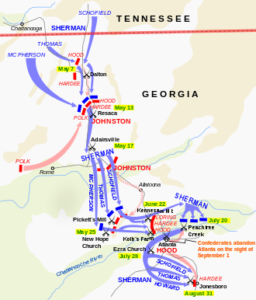 The Atlanta campaign was a series of battles fought in the Western Theater of the American Civil War throughout northwest Georgia and the area around Atlanta during the summer of 1864. Union Maj. Gen. William T. Sherman invaded Georgia from the vicinity of Chattanooga, Tennessee, beginning in May 1864, opposed by the Confederate general Joseph E. Johnston.
The Atlanta campaign was a series of battles fought in the Western Theater of the American Civil War throughout northwest Georgia and the area around Atlanta during the summer of 1864. Union Maj. Gen. William T. Sherman invaded Georgia from the vicinity of Chattanooga, Tennessee, beginning in May 1864, opposed by the Confederate general Joseph E. Johnston.
Johnston’s Army of Tennessee withdrew toward Atlanta in the face of successive flanking maneuvers by Sherman’s group of armies. In July, the Confederate president, Jefferson Davis, replaced Johnston with the more aggressive General John Bell Hood, who began challenging the Union Army in a series of costly frontal assaults. Hood’s army was eventually besieged in Atlanta and the city fell on September 2, setting the stage for Sherman’s March to the Sea and hastening the end of the war.
Background
The Atlanta campaign followed the Union victory in the Battles for Chattanooga in November 1863; Chattanooga was known as the “Gateway to the South”, and its capture opened that gateway. After Ulysses S. Grant was promoted to general-in-chief of all Union armies, he left his favorite subordinate from his time in command of the Western Theater, William T. Sherman, in charge of the Western armies. Grant’s strategy was to apply pressure against the Confederacy in several coordinated offensives. While he, George G. Meade, Benjamin Butler, Franz Sigel, George Crook, and William W. Averell advanced in Virginia against Robert E. Lee, and Nathaniel Banks attempted to capture Mobile, Alabama, Sherman was assigned the mission of defeating Johnston’s army, capturing Atlanta, and striking through Georgia and the Confederate heartland.
Opposing forces
Union
At the start of the campaign, Sherman’s Military Division of the Mississippi consisted of three armies:[5]
- Maj. Gen. James B. McPherson’s Army of the Tennessee (Sherman’s army under Grant in 1863), including the corps of Maj. Gen. John A. Logan (XV Corps), Maj. Gen. Grenville M. Dodge (XVI Corps), and Maj. Gen. Frank P. Blair, Jr. (XVII Corps). When McPherson was killed at the Battle of Atlanta, Maj. Gen. Oliver O. Howard replaced him.
- Maj. Gen. John M. Schofield’s Army of the Ohio, consisting of Schofield’s XXIII Corps and a cavalry division commanded by Maj. Gen. George Stoneman.
- Maj. Gen. George H. Thomas’s Army of the Cumberland, including the corps of Maj. Gen. Oliver O. Howard (IV Corps), Maj. Gen. John M. Palmer (XIV Corps), Maj. Gen. Joseph Hooker (XX Corps), and Brig. Gen. Washington L. Elliott (Cavalry Corps). After Howard took army command, David S. Stanley took over IV Corps.
On paper at the beginning of the campaign, Sherman outnumbered Johnston 98,500 to 50,000,[5] but his ranks were initially depleted by many furloughed soldiers, and Johnston received 15,000 reinforcements from Alabama. However, by June, a steady stream of reinforcements brought Sherman’s strength to 112,000.[6]
Confederate
Opposing Sherman, the Army of Tennessee was commanded first by Gen. Joseph E. Johnston, who was relieved of his command in mid-campaign and replaced by Lt. Gen. John Bell Hood. The four corps in the 50,000-man army were commanded by:[5]
- Lt. Gen. William J. Hardee (divisions of Maj. Gens. Benjamin F. Cheatham, Patrick R. Cleburne, William H. T. Walker, and William B. Bate).
- Lt. Gen. John Bell Hood (divisions of Maj. Gens. Thomas C. Hindman, Carter L. Stevenson, and Alexander P. Stewart).
- Lt. Gen. Leonidas Polk (also called the Army of Mississippi, with the infantry divisions of Maj. Gen. William W. Loring, Samuel G. French, and Edward C. Walthall, and a cavalry division under Brig. Gen. William Hicks Jackson). When Polk was killed on June 14, Loring briefly took over as commander of the corps but was then replaced by Alexander P. Stewart on June 23.
- Maj. Gen. Joseph Wheeler (Cavalry corps, with the divisions of Maj. Gen. William T. Martin and Brig. Gens. John H. Kelly and William Y. C. Humes).
Johnston was a conservative general with a reputation for withdrawing his army before serious contact would result; this was certainly his pattern against George B. McClellan in the Peninsula Campaign of 1862. But in Georgia, he faced the much more aggressive Sherman. Johnston’s army repeatedly took up strongly entrenched defensive positions in the campaign. Sherman prudently avoided suicidal frontal assaults against most of these positions, instead maneuvering in flanking marches around the defenses as he advanced from Chattanooga towards Atlanta. Whenever Sherman flanked the defensive lines (almost exclusively around Johnston’s left flank), Johnston would retreat to another prepared position. Both armies took advantage of the railroads as supply lines, with Johnston shortening his supply lines as he drew closer to Atlanta, and Sherman lengthening his own.
Content retrieved from: https://en.wikipedia.org/wiki/Atlanta_campaign.